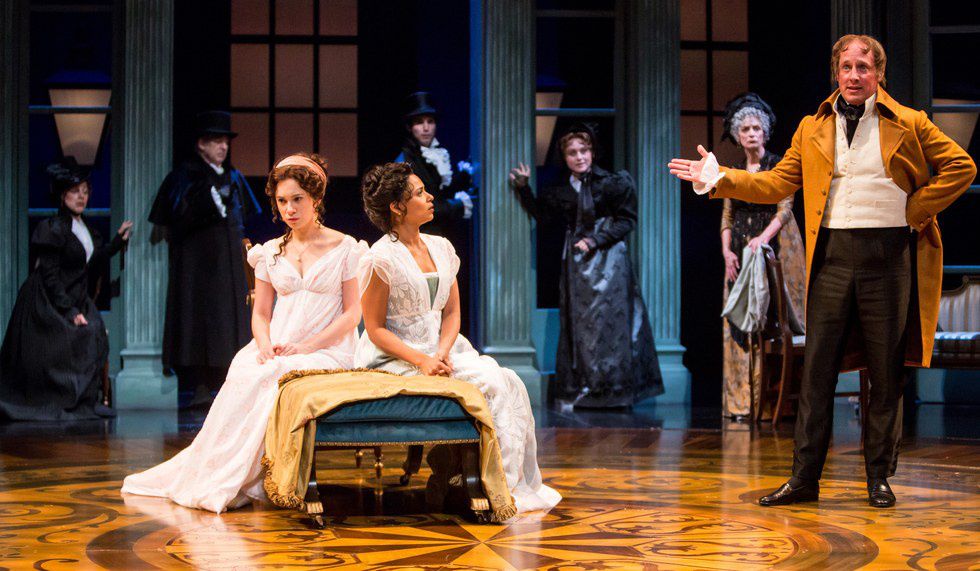I’m fortunate enough to live in the Twin Cities, Minnesota, home to a vibrant theater community. I have the opportunity to see many different kinds of shows all over the city from dance to opera, to experimental theater to classics retold on the stage. One of my favorite places to visit however, is the Guthrie Theater, located on the river on Downtown Minneapolis. It has become my home away from home, I’ve been there so much. One of the shows that is currently running is an adaptation of Sense and Sensibility, based on the novel by Jane Austen.
I am not a Jane Austen fanatic-- I have not read every single one of her books cover to cover, multiple times in my life. In fact, I’ve only read Pride and Prejudice. Nevertheless, I found myself being swept up in this story and taken on quite the ride in Kate Hamill’s stage adaptation.
Recommended for you
The stage itself was amazing. The Wurtele Thrust stage is very adaptable to the vision of the director and behind the scenes team. The floor turned in a clockwise and counterclockwise motion, depending on the needs of the scene. This spinning floor was used in a variety of ways. Actors would go on strolls -- the floor would rotate one way and they would walk against that motion, elongating their walking time on stage. The floor was used during the different dinner parties. The actors would sit in the middle with their chairs facing out towards the audience so we could see their emotions and reactions to what was being said. This added a level of comedy to this adaptation. I admired the turning floor because it showed just how dynamic the actors are and how clever the stage designer and behind-the-scenes folks are. A spinning floor has been used in other shows at the Guthrie, including other Austen adaptations, but I haven’t seen it used with this much purpose before. This was a very fresh idea.
Another important part that stood out to me was the lighting. I never realized just how important lighting can be to a show. It’s not like your stereotypical elementary school play where there is one setting (on) and you just have to deal with it. In this adaptation, lighting is used to highlight certain areas (even just the outer edge of the turning, circular floor). It never been more clear to me how lighting can be used to add or show a certain mood. At one point, the character Marianne was in the center of the stage and people were dancing around her. A distressing situation happened and to show that, the lights turned red and the dancers looked angrier and spun faster around her creating a tense situation. The same couldn’t have happened if there had been bright white lights or any other color or strength of light. I learned so much in this area. Whoever was in charge of lighting design, I want to shadow them and learn all of their tricks.
And finally, the actors. I thought the cast of characters had amazing chemistry together. If you didn’t know any better, Jolly Abraham and Alejandra Escalante, who play Elinor and Marianne Dashwood respectively, could be mistaken for sisters outside of the context of this play. They are so warm towards each other and their interactions seem easy. They were so wonderful to watch together. One of my favorite characters was Margaret Dashwood, the younger sister. Margaret is played part time by Isadora Swan and part time by Natalie Tran. The night I saw the show, Natalie was performing. She was hilarious. She was very blunt in her humor and quick too. I’ve heard that comedy acting is quite difficult, but I thought she made it look easy. Reading up on Natalie in the program, I was surprised to learn that she is so accomplished. She’s been in shows lighter shows like "How The Grinch Stole Christmas" and "The Wizard of Oz" and more mature shows like "Les Miserables" and "South Pacific." And she’s only a sixth grader!
Overall, this was an amazing show. I liked it a lot more than I thought I would.
If you have the chance to see this show before its run is finished on 29 October, it’s well worth it! It’s very touching and you’ll spend a lovely night laughing and enjoying every second of the show.


















